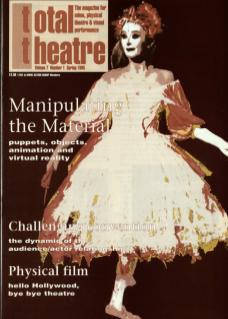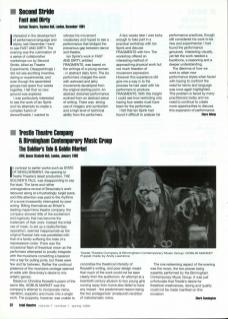Interested in the development of performance language and styles, last December I went to see Fast and Dirty. The evening was the culmination of a series of collaborative workshops run by Second Stride, billed as Theatre Experiments. Disappointingly I did not see anything inventive, daring or experimental, and even though the assembled groups had spent four weeks together, I felt that no new ground was explored.
I was particularly interested to see the work of lan Spink and his attempts to create a complex fusion of dance/theatre. I wanted to witness his movement vocabulary and hoped to see a performance that bridged the precarious gap between dance and theatre.
lan Spink's work in Fast and Dirty, entitled Fragments, was based on the writings of a young woman – in abstract diary form. The six performers charged the work with awkward and jerky movements developed from the original starting point. An abstract distorted performance evolved from an abstract piece of writing. There was strong use of imagery and symbolism and a high level of technical ability from the performers.
A few weeks later I was lucky enough to take part in a practical workshop with Ian Spink and discuss Fragments with him. The workshop offered an interesting method of approaching physical work but not much freedom of movement expression. However, this experience did give me a way in to the process he had used with his performers to produce Fragments. With this insight I could see how restricting only having four weeks must have been for the performers.
I felt that Ian Spink had found it difficult to analyse his performance practices, though still considered his work to be new and experimental. I had found the performance genuinely interesting visually, yet felt the work needed a backbone, a reasoning and a deeper understanding.
The dilemma of how we work to attain new performance styles when faced with having to confront the need for terms and language was once again highlighted. This problem is faced by many practitioners today and we need to continue to create more opportunities to discuss this expansion of performance.

